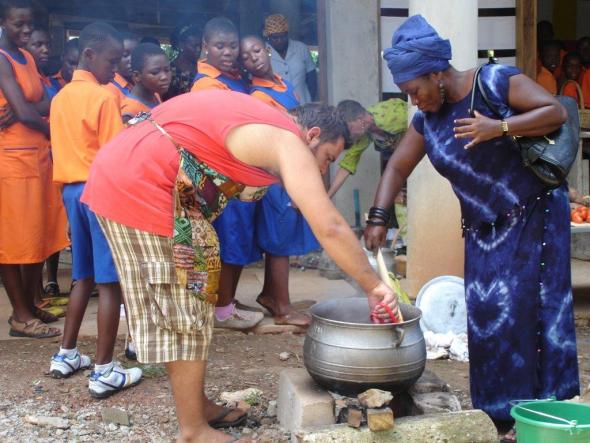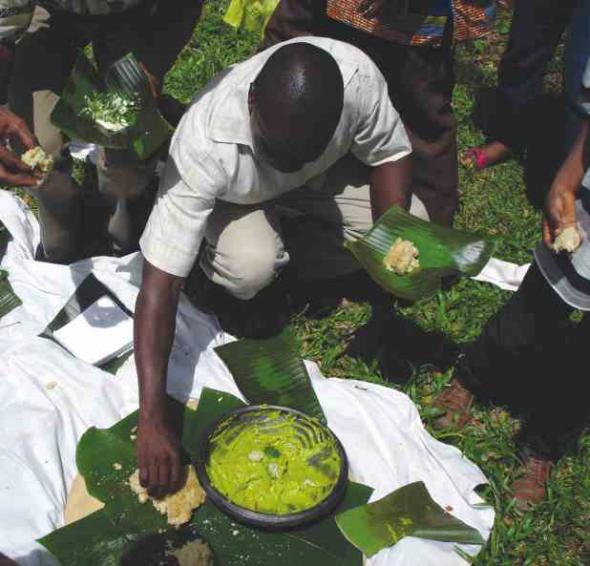AN “OBRONI” IN GHANA From the mouth to the mind
In the rare films on African cultures that were made during the 1950s and 60s, we notice that a distant attitude is adopted to the objects being filmed, a near pudency in relation to the undertaking of discourse on these realities. Les Statues meurent aussi[1] (1953), a film by Chris Marker and Alain Resnais, is an example of this.
In a period in which “knowing” meant “dominating”, this film tells us: “Nous ne savons rien (We know nothing)”.
A lot has changed between then and now. On the plane of relations between artists, for a long time there has existed the desire to work collectively in order to know the other and, in this sense, cultural initiatives are fostered that give rise to the encounter. While it is true that African art largely takes place in the Northern hemisphere, and while its major (political, financial, philosophical, aesthetic etc.) advances have taken place here, it is true that the African continent is increasingly asserting itself as an exceptional relational space for cultural agents.
 In Collaboration (em colaboração). Parte da instalação Cozinhando no Gana
In Collaboration (em colaboração). Parte da instalação Cozinhando no Gana
Although they are a recent part of Jorge Rocha’s artistic practice, food-based experiments have already been carried out in Brazil, Portugal… and Ghana, in Africa. It was here, in 2009, that he held the Sansa International artist’s workshop, within the scope of the Triangle Arts Trust network. The initiative took place in Kumasi in the Ashanti region and brought together twenty artists (ten Ghanaians and ten from further afield) around the various possibilities that were available locally. As Atta Kwami, the coordinator of the workshop, writes: “Kumasi provides a useful model for understanding the complex interrelationship of contemporary visual practice (collage based artists, sign painters, photographers, textile makers, metal workers, carvers, and so forth)”[2].
Originating from countries as varied as China, Iran, and Portugal, the artists who took part in this workshop carried out projects whose results express this encounter not only with Africa but also with the cultural vulnerability of the post-colonial world (politicised, transfigured, codified, rejected, negotiated, sampled etc.).
Jorge Rocha’s work centred on the social relations that are established around food. Let us say that it entered through the mouth of each participant, which is to say, through their desires, needs, and primitivisms. It entered through the mouth, in the centre of Africa. Through its flavours, smells, colours, and tastes.
 Table II(mesa) | Lambda print, 80 x 60 cm
Table II(mesa) | Lambda print, 80 x 60 cm
What we can experience in Lagos is an exhibition, the result of the great banquet, or Babette’s Feast[3] which took place in Ghana but about which “we know nothing”. “OBRONI – Cooking in Ghana: collaboration, community and performative action” is therefore presented as a “document” that records lived experience and the artistic and emotional relations that were established during the experience. While, on the one hand, the exhibition informs us about aspects of the experience of the workshop, on the other hand, it is presented in the form of an installation, simultaneously combining various elements (video, sound, food, the instruments used etc.). “OBRONI…” sends us back to the time of Jorge Rocha’s experience and creation, in other words, to a particular geography and a climate that was right for the journey, which is broadcast to us at a later date but in a wholly synaesthetic form.
The exhibition divides up the different stages associated with the culinary project, thereby conveying a particular interest in the subjects: “Francisca”; in the moments of shared eating: “Table II”; and, obviously, in the Kelewele recipes, “In collaboration: Pounding Fufu”, or “In the table: Migas d’Alho”.
 Table | Lambda print, 80 x 60 cm
Table | Lambda print, 80 x 60 cm
One of the elements that stands out in the series comprising the exhibition is the “table” where the artists-commensals shared meals and experiences of life. It is a white square, arranged on the ground, whose graphical characteristics recall road signs. It also calls to mind a patio, or a cloister, which does not seem far removed from the idea of Eden. For Rocha, this white “table” also relates to the title of this project – obroni – a word used by Ghanaians to identify white people. “Obroni! Obroni!”, they would shout at him as he walked around the markets of Kumasi. In the markets of some African countries, this is a regular occurrence.
According to Rocha, the term expansive culinary refers to projects which value the “(…) specific action of cooking, the gestures of the person cooking and the social act of the meal”
In strategic terms, the use of the word “expansive” in this context refers to the 1960s, in which prevailing grammars and methods underwent a radical change. In the particular case of this project, it is a question of adapting a “millennial art” to the new vocabulary of the contemporary world, namely, the active participation of the spectator and the alteration of the meaning of the culturally familiar world of cooking. Rocha refers to this space of experimentation as a “laboratory zone” which has “a pictorial and perfomative nature”, thereby subverting the cultural roles associated with the world of cooking. What is implied is a readjustment of the usual ways of seeing and doing. From the mouth to the mind.
[1] Marker/Resnais (1953): Les Statues meurent aussi, documentary.
[2] “Hands on Art”, Sansa III, 9-16 June 2009, Kumasi, Ghana.
[3] AXEL, Gabriel (1987): Babettes Gaestebud, film. English translation “Babette’s Feast”, based on the novel by Karen Blixen. It tells the story of Babette, a famous Parisian cook who is in exile in Denmark during the time of the Paris Commune. A lucky lottery ticket leads to her preparing the most sumptuous of French gastronomic feasts.
 In the table II (na mesa II), Lambda print, 62 x 60 cm
In the table II (na mesa II), Lambda print, 62 x 60 cm